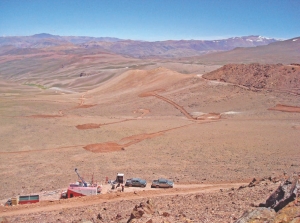VANCOUVER — Its flagship Don Sixto gold project is still on hold because of Argentinean politics but Exeter Resource (XRC-V, XRA-X)keeps moving along, buoyed by promising results from its Caspiche copper-gold project in Chile and a $35-million financing.
At Caspiche, located in the Maricunga gold district, hole 15 intersected 632 metres grading 0.7 gram gold per tonne, starting 58 metres down-hole. The mega-intercept includes 152 metres grading 0.93 gram gold and 0.3% copper, indicating increasing grades with depth. And the drill continued in porphyry-style mineralization to a depth of 1,001 metres; assays are still pending for the final 369 metres.
Exeter also announced full assay results for hole 14 — the company released results from the top 200 metres in mid-February. Hole 14 was drilled 400 metres southeast of hole 15 and returned 593 metres grading 0.44 gram gold and 0.25% copper from 148 metres depth, including 131 metres grading 0.6 gram gold and 0.23% copper from 610 metres.
Hole 13, the first into the Caspiche main zone, was a reverse-circulation (RC) drill hole that pulled up 304 metres grading 0.9 gram gold from 40 metres, and terminated at the drill rig’s depth limit, still in mineralization. Hole 13 sits 250 metres east of hole 15.
Exeter believes hole 15 is located centrally within the porphyry system because it intersected potassic alteration up to its depth extent. Hole 14, on the other hand, intersected phyllic alteration, suggesting it is located nearer the edge of the porphyry system.
To test the outline of the mineralized zone, Exeter is drilling large stepouts. Hole 16 was collared between holes 14 and 15, to better define the boundary between potassic and phyllic alteration. Hole 18 is located 500 metres northwest of hole 15, targeting a strong geophysical anomaly that may define the limit of the system in that direction or indicate the presence of a new system.
Mineralization at Caspiche consists of a near-surface, potentially leachable oxide zone hosting gold, but not copper. In hole 13, the oxide zone started 40 metres below surface and reached to a depth of 214 metres, grading 0.88 gram gold. Hole 14 saw oxide from surface to 60 metres depth, with an average grade of 0.7 gram gold. And in hole 15 the oxide layer started at 58 metres depth and reached for 56 metres, grading 0.35 gram gold.
Below the oxide blanket, mineralization is typical porphyry-style primary copper-gold.
For years, Anglo American (AAUK-N, AAL-L) held the properties that make up Caspiche. In 2005, Exeter signed an option agreement with the major — the junior can earn a 100% interest in the project by spending US$2.5 million on exploration and completing 15,500 metres of drilling. Anglo would be entitled to a 3% net smelter return royalty from production.
When Exeter started exploring Caspiche, it targeted potential high-grade epithermal mineralization in the northern and eastern parts of the project, an area called Caspiche III. However, an initial drill program indicated that the mineralization at Caspiche III was deeper than expected.
In a second drill campaign, six holes continued to probe Caspiche III, but one hole tested a pronounced induced-polarization (IP) anomaly delineated in previous exploration work. That was hole 13, with its 304- metre intercept. Exeter had found the Caspiche main zone.
Assay results from the discovery hole were announced in May 2007. A new drill program at Caspiche got under way recently and holes 14 and 15 are the only results to date from that program. Exeter plans to complete 6,000 metres of diamond drilling and 1,200 metres of RC drilling in the program, using two diamond-drill rigs and one RC rig.
In other Exeter news, the company closed its previously announced $35-million financing. It sold 7.78 million special warrants at $4.50 apiece, exercisable for one share.
The latest drill results and financing news boosted Exeter’s share price 22 or 5% to close at $4.49. The company has a 52-week trading range of $1.97-5.92 and has 41.3 million shares issued.


Be the first to comment on "Exeter’s Caspiche delivers long intercepts"